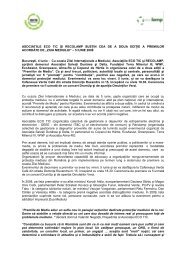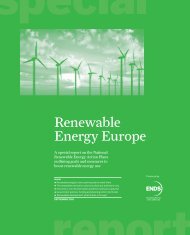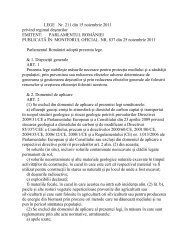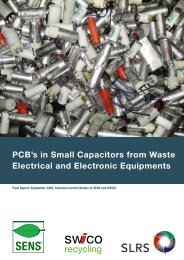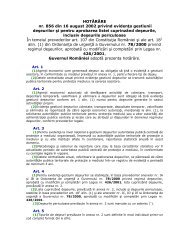The challenge of transposing WEEE II into national law - WEEE Forum
The challenge of transposing WEEE II into national law - WEEE Forum
The challenge of transposing WEEE II into national law - WEEE Forum
Create successful ePaper yourself
Turn your PDF publications into a flip-book with our unique Google optimized e-Paper software.
<strong>II</strong>.<strong>WEEE</strong> arisingTraditionally, <strong>WEEE</strong> has been a complex waste stream to understand. <strong>The</strong>re are manyactors involved, and the channels through which <strong>WEEE</strong> is collected are very diverse.So, it is difficult to determine how much <strong>WEEE</strong> actually arises, especially the quantities<strong>of</strong> <strong>WEEE</strong> that are captured but not recorded, and also the tonnages that are notseparately collected at all by any actor and disappear in the municipal waste stream. Inother words, we know how much is collected and treated on a <strong>national</strong> level by therecognised (producer) compliance schemes, but we have little evidence about the nonreportedquantities, i.e. <strong>WEEE</strong> collected by the other actors outside the <strong>of</strong>ficial system,for example small door-to-door trade, second hand shops, <strong>WEEE</strong> in residual wastefrom households or businesses and/or exported (illegally) out <strong>of</strong> sight.We need to understand more about how much, where and what type <strong>of</strong> <strong>WEEE</strong> isarising (or generated) in order to maximise collection.In March 2012, the Dutch producer compliance schemes organised aninter<strong>national</strong> event on <strong>WEEE</strong>: ‘<strong>The</strong> Future Flows’ (seewww.wecycle.nl/futureflows). Insights were presented about the quantities <strong>of</strong>electrical and electronic equipment marketed and <strong>of</strong> <strong>WEEE</strong>, their‘complementary’ flows – formerly known as ‘leakages’ – their lifetimes,discarding and re-use behaviour and imports and exports for re-use andrecycling. A study was also commissioned to estimate the ‘<strong>WEEE</strong> arising’ on thebasis <strong>of</strong> a model developed by the United Nations University, which establishesa connection between the sales and possession <strong>of</strong> a product and when it isdiscarded at the end <strong>of</strong> its useful life. In addition, the model establishes aconnection between the discretionary income <strong>of</strong> a country’s population and theexpected volume <strong>of</strong> discarded electrical equipment in that market. <strong>The</strong> studydoes reiterate, however, that there are many other sources <strong>of</strong> data that canalso be used to further fine-tune the model.<strong>WEEE</strong> TRACE, a cooperative project co-funded by the European ExecutiveAgency for Competitiveness and Innovation (EACI), aims to ensure ‘cradle-tograve’traceability <strong>of</strong> complete <strong>WEEE</strong> flows by means <strong>of</strong> the use <strong>of</strong> advancedinformation and communication technologies (see www.weee-trace.eu). <strong>WEEE</strong>is itemised with RFID to ensure traceability, identification <strong>of</strong> <strong>WEEE</strong> flows,illegal exports and information for recyclers on recyclability. <strong>The</strong> data canpossibly be linked to a <strong>WEEE</strong> register. <strong>The</strong> six project partners represent thewhole life cycle <strong>of</strong> electrical and electronic appliances from design andmanufacturing to the final collection and recycling <strong>of</strong> these appliances at theend <strong>of</strong> their useful lives. Two producer compliance schemes from Spain and theCzech Republic take part in the project.Page | 3
<strong>II</strong>I.Handover <strong>of</strong> <strong>WEEE</strong>It is estimated that around 30-40 per cent <strong>of</strong> <strong>WEEE</strong> is currently recorded in the <strong>of</strong>ficialsystems in Europe. That is not to say 60-70 per cent is not collected, but that, on theone hand, there are still many un<strong>of</strong>ficial channels collecting <strong>WEEE</strong> which are notrecorded in the <strong>of</strong>ficial system and, on the other hand, some <strong>WEEE</strong> is still notseparately collected. With the new targets in place, it will be important that producersare only responsible for the tonnages they have access to, and nothing more. Allproducers agree that they are willing to be 100 per cent responsible for the <strong>WEEE</strong> theyhave access to.Essentially, there are two options: Count <strong>WEEE</strong> from all actors in the system, or ensureall <strong>WEEE</strong> is dealt with by approved producer compliance schemes.Many producers are keen to see the first <strong>of</strong> these approaches enforced (see V<strong>II</strong>), but insome member states it is possible that the latter approach can also be successful. Forexample, in smaller compliance markets, with only one or a few producer complianceschemes in operation and also a good understanding with authorities, for exampleIreland, Belgium, Sweden or the Netherlands, mandatory giveback may be the mosteffective way <strong>of</strong> recovering <strong>WEEE</strong> within the <strong>of</strong>ficial channels.Article 5(4) in <strong>WEEE</strong> <strong>II</strong>:“Member States may require that the <strong>WEEE</strong> deposited at collection facilitiesreferred to in paragraphs 2 and 3 is handed over to producers or third partiesacting on their behalf or is handed over, for purposes <strong>of</strong> preparing for re-use, todesignated establishments or undertakings.”IV.Consumers returning <strong>WEEE</strong>Having discussed the above (see <strong>II</strong>I), it is important to recognise that there is still roomfor improvement in influencing consumer habits when it comes to disposing <strong>of</strong> <strong>WEEE</strong>.<strong>The</strong>re is huge discrepancy in the level <strong>of</strong> understanding <strong>of</strong> consumers across allmember states as to the importance <strong>of</strong> returning <strong>WEEE</strong> to collection points or have<strong>WEEE</strong> separately collected. It takes time for people to become accustomed to whatthey need to do.Ultimately, how much <strong>WEEE</strong> gets collected depends a great deal on the disposer’sbehaviour, whether or not he/she returns the <strong>WEEE</strong> to registered collection points andhas it collected by registered parties.Many member states, in co-operation with producer compliance schemes andother stakeholders, are already very active in driving consumer awareness,undertaking public campaigns to actively engage consumers and encouragethem to return their end-<strong>of</strong>-life appliances responsibly. See the <strong>WEEE</strong> <strong>Forum</strong>2011 annual report http://www.weee-forum.org/what-is-the-weee-forum(pages 10-11) for a selection <strong>of</strong> examples and a summary <strong>of</strong> <strong>WEEE</strong> <strong>Forum</strong>project reports.Page | 4
For example, the Czech Republic has shown how it is possible to engage thepublic via its ‘Feed the Scrapman’ campaign, which saw a giant dinosaur madeup <strong>of</strong> pieces <strong>of</strong> <strong>WEEE</strong> created over a four day period. Everyone who ‘fed’ thescrapman and answered a quiz question was awarded a prize. This activitywas supported with educational activities, so actively educating members <strong>of</strong>the public that they should return their end-<strong>of</strong>-life appliances to collectionpoints (see http://www.asekol.cz/en/consumers/education-and-publicawareness/the-feed-the-scrapman-campaign.html).In Ireland, citizens proved receptive to a popular reality TV programme,involving citizen action, rather than just traditional adverts where a viewer ispassive.Scandinavians and Swiss are typically acutely aware <strong>of</strong> environmental issuesand therefore more likely to return <strong>WEEE</strong> to collection points.Lots <strong>of</strong> campaigns rolled out via schools achieve good success and engagement,such as in Portugal, Italy, Slovakia and the Netherlands.With respect to household collection, a proper interpretation <strong>of</strong> the Directive will becritical to its success. Article 12(1), in relation to financing in respect <strong>of</strong> <strong>WEEE</strong> fromprivate households, states that:“Member States shall ensure that producers provide at least for the financing<strong>of</strong> the collection, treatment, recovery and environmentally sound disposal <strong>of</strong><strong>WEEE</strong> from private households that has been deposited at collection facilitiesset up under Article 5(2).”Introducing parallel collection schemes would have a negative environmental impactand result in consumers having to pay twice. Responsibility for household collectiondoes not bring any further incentive on improving design for end-<strong>of</strong>-life, one <strong>of</strong> theobjectives <strong>of</strong> the Directive.Municipalities should remain responsible for financing household collection. Producersshould continue to be responsible for <strong>WEEE</strong> once it has been handed over to theproducer compliance schemes.V. Access to <strong>WEEE</strong>Producers are responsible for the effective treatment <strong>of</strong> <strong>WEEE</strong>, so it is essential thatthe producer compliance schemes have access to the <strong>WEEE</strong> collected, and caninfluence where it goes for treatment, how much it costs, the quality <strong>of</strong> the treatmentand, ultimately, improve the auditability <strong>of</strong> the recycling chain.With access to <strong>WEEE</strong>, producer compliance scheme can also influence what happensto the raw materials that are recovered as part <strong>of</strong> the process – this is particularly keyfor the recovery <strong>of</strong> rare earths, precious metals and other critical materials.In terms <strong>of</strong> transposition <strong>of</strong> <strong>WEEE</strong> <strong>II</strong>, article 5(4) will be crucial:“Member States may require that the <strong>WEEE</strong> deposited at collection facilitiesreferred to in paragraphs 2 and 3 is handed over to producers or third partiesPage | 5
acting on their behalf or is handed over, for purposes <strong>of</strong> preparing for re-use, todesignated establishments or undertakings.”Everyone agrees that we must capture as much <strong>WEEE</strong> as possible, but producers canonly be responsible for capturing what is there. In order to improve the efficiency <strong>of</strong><strong>WEEE</strong> captured and treated within the system, <strong>WEEE</strong> <strong>II</strong> includes the points below inaddition to the current requirements:“Member states shall prohibit the disposal <strong>of</strong> separately collected <strong>WEEE</strong> whichhas not yet undergone the treatment specified in article 8.”This should mean that <strong>WEEE</strong> from all sources is properly treated and counted, andshould help to prevent illegal exports and improve the amount counted towards thetarget.<strong>The</strong> UK currently works on a system <strong>of</strong> tradable certificates called evidencenotes. Collectively, evidence notes represent the total amount <strong>of</strong> <strong>WEEE</strong>collected in any year. One <strong>of</strong> the main issues in the UK system is that there isthe potential for several parties (intermediaries) to become involved in therecycling chain and where this happens, and <strong>WEEE</strong> evidence is transferred ortraded, its origin becomes untraceable and the audit trail becomes longer andless clear – which means the risk <strong>of</strong> leakage and the illegal export <strong>of</strong> <strong>WEEE</strong>increases.In theory, the act <strong>of</strong> trading or transfer <strong>of</strong> evidence is intended to be a year-endbalancing activity, as every note must be owned by schemes in the correctproportion. However, in reality, if a producer compliance scheme has evidencethat it doesn’t directly need it to meet its own members’ obligations, then therewill be another PCS which does need it, and therefore, will be forced to buy itfrom them regardless <strong>of</strong> cost or origin. This practice is still widespread.<strong>The</strong> risk <strong>of</strong> leakage can significantly decrease where there is a directrelationship between those collecting <strong>WEEE</strong> and a PCS that actually needs anddirectly finances the <strong>WEEE</strong> for its members’ obligations. For example, where aretailer collects from a consumer and then passes this directly onto adesignated collection facility or an approved treatment facility in agreementwith a PCS, then there is significantly less opportunity for the illegal collectors<strong>of</strong> <strong>WEEE</strong> to get their hands on it. This is because the audit trail is far shorter,making it easier to know where <strong>WEEE</strong> comes from, where it goes to and whopays for its treatment.VI.Methods <strong>of</strong> allocating <strong>WEEE</strong>Effective <strong>national</strong> <strong>WEEE</strong> systems in Europe tend to have a (centralised) method <strong>of</strong>allocation.This method <strong>of</strong> allocation may be based on a single producer compliance schemetaking ownership or on an allocation system in which various schemes areparticipating. But essentially, a regulated system for allocation will help to balance theprocess in an orderly fashion.Page | 6
“7 years after entry <strong>into</strong> force <strong>of</strong> this directive the minimum collection rate tobe achieved annually shall be 65% <strong>of</strong> EEE placed on the market in the threepreceding years or alternatively 85% <strong>of</strong> <strong>WEEE</strong> generated on its territory.”And importantly, from now until January 1st 2016:“[…] a rate <strong>of</strong> separate collection <strong>of</strong> at least 4 kilograms per inhabitant peryear <strong>of</strong> <strong>WEEE</strong> from private households is collected or the same amount <strong>of</strong>average weight <strong>of</strong> <strong>WEEE</strong> that was collected in that member state in the threepreceding years, whichever is greater.”This latter target, based on <strong>WEEE</strong> arising (see <strong>II</strong>), better reflects the individual nature<strong>of</strong> <strong>WEEE</strong> generated in each member state and is favoured by many stakeholders.In August 2012, France passed a <strong>law</strong> that all payments for scrap metal shouldbe cashless and that any payment must be made by bank transfer. Previously,80 per cent <strong>of</strong> payments for metals in France were made in cash.In Britain, changes to the <strong>law</strong> have made cash sales for metal scrap illegal.About 15,000 tonnes <strong>of</strong> metal are stolen every year – as much as half fromscrap metal dealers – though the industry and commercial victims agree thefigure is an underestimate.<strong>WEEE</strong> <strong>II</strong> lays down new and challenging collection targets. To assist theproducer responsibility organisations <strong>of</strong> the <strong>WEEE</strong> <strong>Forum</strong> achieve thesecollection targets, a <strong>WEEE</strong> <strong>Forum</strong> project, presented early 2012, identifiedgood practices in collection in terms <strong>of</strong> strategies, tools and methods, andspecial events. As regards events, measuring the cost-effectiveness in relationto the collection rates has not been attempted by any compliance scheme – toomany other factors contribute to the collection rate increase. Mobile collectionand school programmes, and programmes that combine a message and a type<strong>of</strong> collection, show increase in the collection rates over time.<strong>The</strong> producer compliance scheme in Poland put in place an effective lampscollection scheme.V<strong>II</strong>I.Enforcing the rulesAll sorts <strong>of</strong> parties dodge the system. <strong>The</strong>re are free-riders among producers – thosethat fail to register with the <strong>of</strong>ficial system – and among operators that have notregistered. As part <strong>of</strong> the transposition <strong>into</strong> <strong>national</strong> <strong>law</strong>, it will be crucial to set strictand clear enforcement measures, with penalties adhered to by the enforcing bodies.It is the authorities’ responsibility to survey the market and ensure that justice is servedon any free-riders in the system.“In Ireland, several companies were prosecuted for falling foul <strong>of</strong> Irish <strong>law</strong>. Onemajor retailer pleaded guilty to charges brought by the EnvironmentalProtection Agency in relation to <strong>of</strong>fences under the <strong>WEEE</strong> regulation. <strong>The</strong>company was fined €1,500 and ordered to pay a further €10,000 to the EPA incosts for failure to state the correct producer recycling fund contribution in aPage | 8
ochure and for failing to maintain a statutory notice in-store alertingcustomers to the fact that price include such a contribution to ensure that<strong>WEEE</strong> is collected and recycled in a responsible manner. To date, the Irish EPAhas taken ten prosecutions under the <strong>WEEE</strong> Regulations for failure to complywith producer or retailer obligations with over €100,000 in fines and/or costsawarded against these companies in total as a result (seehttp://www.epa.ie/downloads/pubs/waste/weee/Enforcement%20update%20note%20November%202011.pdf).Enforcement is the ultimate responsibility <strong>of</strong> the authorities. However in somecountries, producer compliance schemes help authorities in identifying free-riders..<strong>The</strong> main compliance scheme in Belgium has personnel engaged in travellingaround the territory and identifying appliances placed on the market by freeriders.IX.Qualified ban on exportsEnsuring that the treatment <strong>of</strong> <strong>WEEE</strong> is properly reported in the <strong>of</strong>ficial channels willmean that less is allowed to escape to illegal export.Any party that wishes to ship used equipment abroad should be in a position to provideevidence that the equipment is functioning and can be re-used.<strong>The</strong> <strong>WEEE</strong> <strong>Forum</strong> is currently a partner in a consortium which will analyse<strong>WEEE</strong> data and current crime patterns. This will aim to bring together datacurrently in existence – including everything that is legally collected, andeverything outside <strong>of</strong> that, to identify gaps and patterns in illegal export. Thisproject, dubbed CWIT (Countering <strong>WEEE</strong> Illegal Trading), is due to start inJanuary 2013.X. Responsible re-useProducers recognise that there is an environmental benefit <strong>of</strong> re-use, but this needs tobe quantified and regulated. For example, the credibility for refurbished products canbe improved by requiring re-use organisations to be qualified. Qualification may hingeon standards concerning how the equipment should be refurbished by the re-useorganisation and the identification on products (marking) <strong>of</strong> who has refurbished.<strong>The</strong> <strong>WEEE</strong> regulations should allow access for qualified re-use organisation tocollection points to pick any waste product for their refurbishment activity. Any materialthat cannot be used by the re-use organisation needs to be handed back to the samecollection point.Page | 9
Any refurbishment <strong>of</strong> <strong>WEEE</strong> – the so-called ‘preparation for re-use’ – <strong>into</strong> newappliances should be performed by accredited re-use centres and should be subject toregulations concerning the use <strong>of</strong> certain hazardous substances (RoHS), safety andeco-design in force when the refurbishment is performed. And any requirements shouldmeet certain conditions, e.g. enforceability, relevance and competitive pro<strong>of</strong>ing.In France, preparation for re-use plays an important role and there is a strongsocial focus on these activities. <strong>The</strong> producer compliance schemes work closelywith the municipalities and the re-use organisations to facilitate the re-use <strong>of</strong>appliances which are deposited at municipal sites.XI.Responsible processingUnder the new Directive, standards for collection, transport and treatment will bedeveloped. This will level the playing field among recyclers and define qualityrequirements for operators.In the past four years, the <strong>WEEE</strong> <strong>Forum</strong> has co-ordinated a major project,<strong>WEEE</strong>LABEX, co-financed by the EU’s LIFE programme, aiming at laying downa set <strong>of</strong> European standards with respect to the collection, sorting, storage,transportation, preparation for re-use, processing and disposal <strong>of</strong> all kinds <strong>of</strong><strong>WEEE</strong>. <strong>The</strong> world’s first coherent, comprehensive and continental set <strong>of</strong>standards, approved by the <strong>WEEE</strong> <strong>Forum</strong> in April 2011, covers all 10 <strong>WEEE</strong>categories and directly affects all parties involved in the <strong>WEEE</strong> chain <strong>of</strong>operations. <strong>WEEE</strong>LABEX will change the <strong>WEEE</strong> landscape substantially andfor good. See www.weee-forum.org/weeelabexproject.X<strong>II</strong>.Responsible financingSome member states will push for mandatory visible fees, while others will not see it asa priority – it very much depends on the individual systems currently existing in eachmember state. We have seen the visible fee model works very well in some countries.Visible fees allow for transparency – everyone can scrutinise compliance schemes’reports to see how the money is spent. <strong>The</strong>y are cost-effective, because no pr<strong>of</strong>itmargins are added to the bill, and do not disrupt competitive market conditions. Studieshave shown that consumers accept the visible fee.It should be legally possible to make costs <strong>of</strong> <strong>WEEE</strong> management transparent.<strong>The</strong> producer responsibility organisations in Ireland, France, Belgium and theNetherlands, amongst others, have successfully implemented visible feeschemes.Page | 10
X<strong>II</strong>I.Resource efficiencyIn an ideal world, all materials would be used for the manufacture <strong>of</strong> new products,using waste as a resource and reducing our environmental footprint. We are a longway <strong>of</strong>f this, but we should strive for this as an end result, with all the systems andprocesses we put in place taking us one step further.Eco-design is the process <strong>of</strong> designing a product in such a fashion that its ecologicalimpact is reduced through its life cycle. This includes the extraction <strong>of</strong> materials, themanufacturing <strong>of</strong> the product, its distribution, the use and the disposal <strong>of</strong> the product.<strong>The</strong> idea is to identify elements during this process that have significant influence onthe environmental impacts. <strong>The</strong> existing producer responsibility for treatment can actas an important driver for improving end-<strong>of</strong>-life design aspects.<strong>The</strong>re are many metals that can be recovered from electronic consumer goods.Recoverable quantities <strong>of</strong> critical raw materials are present in a portion <strong>of</strong> the <strong>WEEE</strong>flow, mainly in low-energy light bulbs, batteries, cathode ray tubes, flat panels, mobilephones and printed circuit boards. <strong>The</strong> better performing treatment plants can recovera high volume <strong>of</strong> the precious metals it contains.A good example <strong>of</strong> a ‘Best <strong>of</strong> Two Worlds’ approach is provided by WorldPC(see www.worldpc.org), an NGO that seeks to have PCs dismantled in Africa,creating local jobs, but then send back the circuit boards to a state-<strong>of</strong>-the-artrecycling plant in Europe to ensure recovery <strong>of</strong> precious metals and othercritical materials. <strong>The</strong> <strong>WEEE</strong> <strong>Forum</strong> has signed a partnership with WorldPC.<strong>The</strong> <strong>WEEE</strong>LABEX standards on collection, handling, transporting, storing andprocessing <strong>of</strong> <strong>WEEE</strong> (see XI) contribute to better de-pollution <strong>of</strong> hazardous<strong>WEEE</strong>. <strong>The</strong> next step could be to expand the standards to include therequirement to recover certain types <strong>of</strong> critical metals. <strong>The</strong> main compliancescheme in Belgium, for example, has integrated such requirements concerningthe recovery <strong>of</strong> palladium, gold, silver and aluminium from printed circuitboards <strong>into</strong> its contracts.Page | 11
About the <strong>WEEE</strong> <strong>Forum</strong><strong>The</strong> <strong>WEEE</strong> <strong>Forum</strong> (www.weee-forum.org) is a European non-pr<strong>of</strong>it association speaking for 41 electricaland electronic equipment waste (<strong>WEEE</strong>) producer compliance schemes – alternatively referred to as‘producer responsibility organisations’ (PRO). It was set up in the early 2000s. <strong>The</strong> 41 PROs are based inAustria, Belgium, Czech Republic, Denmark, Italy, Germany, Greece, France, Hungary, Ireland, Lithuania,the Netherlands, Norway, Poland, Portugal, Romania, Slovakia, Slovenia, Spain, Sweden, Switzerland andthe United Kingdom. It is the biggest organisation <strong>of</strong> its kind in the world. In 2011, its memberorganisations reported collection and proper de-pollution and recycling <strong>of</strong> about 2 million tonnes <strong>of</strong> <strong>WEEE</strong>.Members in 2012: Amb3E, Appliances Recycling, Asekol, Asekol SK, EcoAsimelec, Ecodom, Ec<strong>of</strong>imática,Ecolec, Ecologic, Ecoped, Eco-RAEE's, ecoR’it, Eco-systèmes, Ecotic, Eco Tic, EEPA, ElectroCoord,ElektroEko, Elektrowin, El-Kretsen, elretur, el retur, Envidom, Fotokiklosi, ICT Milieu, Lightcycle, Lumicom,RAEcycle, Recicla Canaria, Recupel, ReMedia, Repic, Retela, RoRec, SENS, SLRS, SWICO, UFH,Wecycle, <strong>WEEE</strong> Ireland and Zeos.For more information, please contact Pascal Leroy, Secretary General <strong>of</strong> the <strong>WEEE</strong><strong>Forum</strong>: pascal.leroy@weee-forum.org.Page | 12



